oil level FIAT BARCHETTA 2003 1.G Owners Manual
[x] Cancel search | Manufacturer: FIAT, Model Year: 2003, Model line: BARCHETTA, Model: FIAT BARCHETTA 2003 1.GPages: 170, PDF Size: 3.55 MB
Page 31 of 170
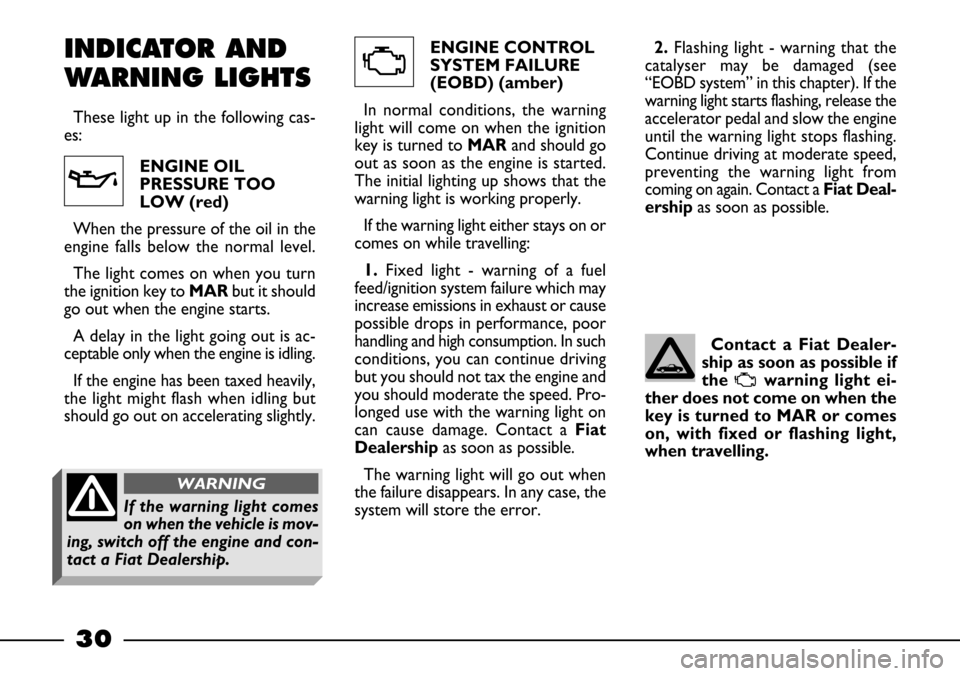
ENGINE CONTROL
SYSTEM FAILURE
(EOBD) (amber)
In normal conditions, the warning
light will come on when the ignition
key is turned to MARand should go
out as soon as the engine is started.
The initial lighting up shows that the
warning light is working properly.
If the warning light either stays on or
comes on while travelling:
1.Fixed light - warning of a fuel
feed/ignition system failure which may
increase emissions in exhaust or cause
possible drops in performance, poor
handling and high consumption. In such
conditions, you can continue driving
but you should not tax the engine and
you should moderate the speed. Pro-
longed use with the warning light on
can cause damage. Contact aFiat
Dealershipas soon as possible.
The warning light will go out when
the failure disappears. In any case, the
system will store the error. ENGINE OIL
PRESSURE TOO
LOW (red)
When the pressure of the oil in the
engine falls below the normal level.
The light comes on when you turn
the ignition key to MARbut it should
go out when the engine starts.
A delay in the light going out is ac-
ceptable only when the engine is idling.
If the engine has been taxed heavily,
the light might flash when idling but
should go out on accelerating slightly.
30
v
U
INDICATOR AND
WARNING LIGHTS
These light up in the following cas-
es:2.Flashing light - warning that the
catalyser may be damaged (see
“EOBD system” in this chapter). If the
warning light starts flashing, release the
accelerator pedal and slow the engine
until the warning light stops flashing.
Continue driving at moderate speed,
preventing the warning light from
coming on again. Contact a Fiat Deal-
ership as soon as possible.
Contact a Fiat Dealer-
ship as soon as possible if
the
Uwarning light ei-
ther does not come on when the
key is turned to MAR or comes
on, with fixed or flashing light,
when travelling.
If the warning light comes
on when the vehicle is mov-
ing, switch off the engine and con-
tact a Fiat Dealership.
WARNING
Page 83 of 170
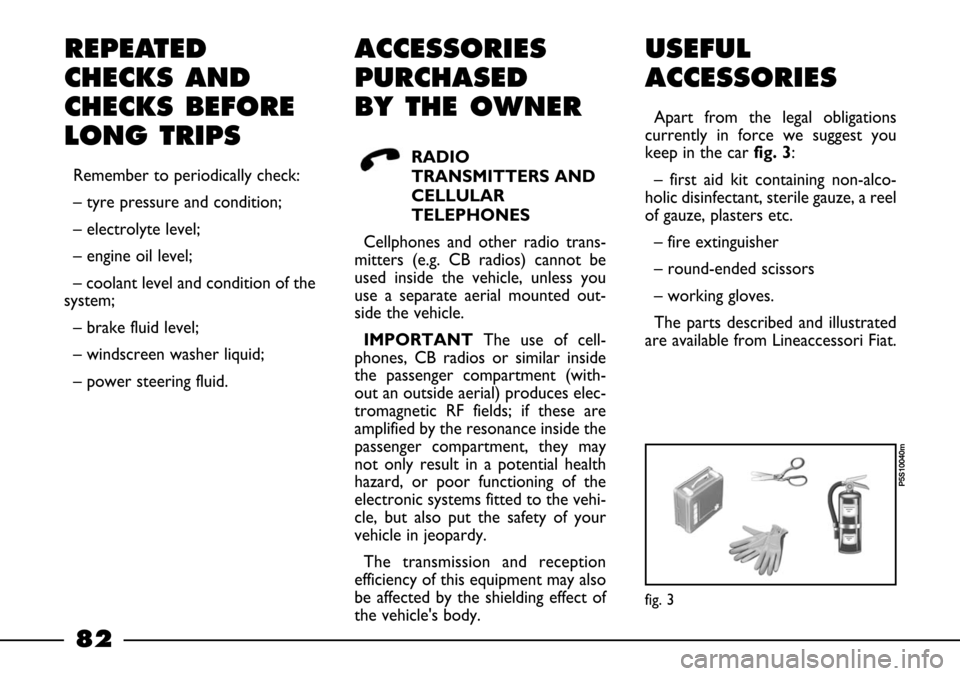
82
REPEATED
CHECKS AND
CHECKS BEFORE
LONG TRIPS
Remember to periodically check:
– tyre pressure and condition;
– electrolyte level;
– engine oil level;
– coolant level and condition of the
system;
– brake fluid level;
– windscreen washer liquid;
– power steering fluid.
ACCESSORIES
PURCHASED
BY THE OWNER
RADIO
TRANSMITTERS AND
CELLULAR
TELEPHONES
Cellphones and other radio trans-
mitters (e.g. CB radios) cannot be
used inside the vehicle, unless you
use a separate aerial mounted out-
side the vehicle.
IMPORTANTThe use of cell-
phones, CB radios or similar inside
the passenger compartment (with-
out an outside aerial) produces elec-
tromagnetic RF fields; if these are
amplified by the resonance inside the
passenger compartment, they may
not only result in a potential health
hazard, or poor functioning of the
electronic systems fitted to the vehi-
cle, but also put the safety of your
vehicle in jeopardy.
The transmission and reception
efficiency of this equipment may also
be affected by the shielding effect of
the vehicle's body.
USEFUL
ACCESSORIES
Apart from the legal obligations
currently in force we suggest you
keep in the car fig. 3:
– first aid kit containing non-alco-
holic disinfectant, sterile gauze, a reel
of gauze, plasters etc.
– fire extinguisher
– round-ended scissors
– working gloves.
The parts described and illustrated
are available from Lineaccessori Fiat.
fig. 3
P5S10040m
Page 115 of 170
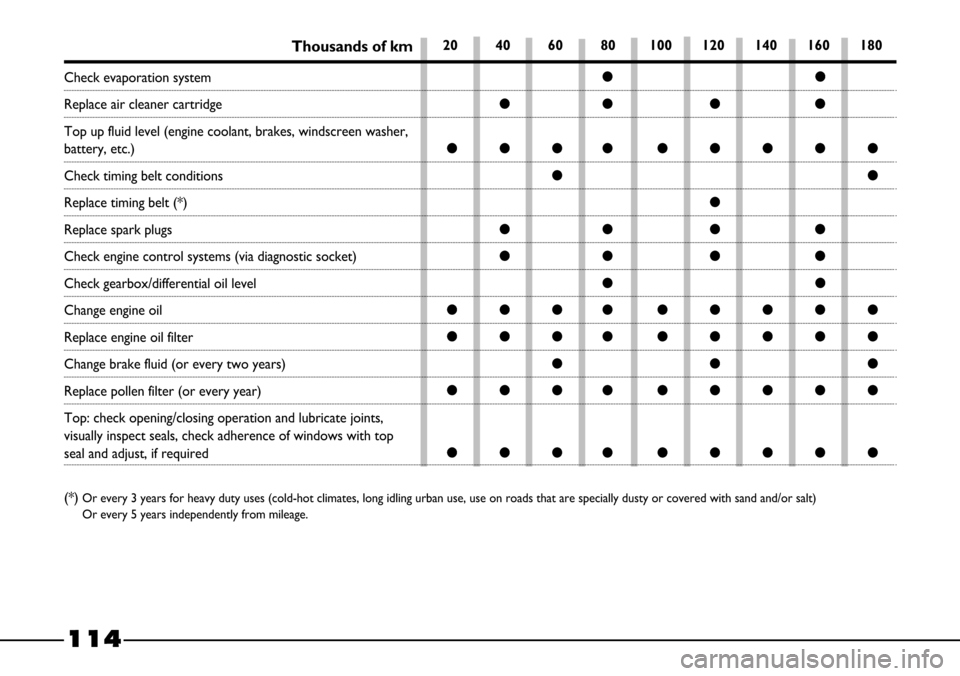
114
(*) Or every 3 years for heavy duty uses (cold-hot climates, long idling urban use, use on roads that are specially dusty or covered with sand and/or salt)
Or every 5 years independently from mileage.
Thousands of km
çç
çç ç ç
çççç ççççç
çç
ç
çç ç ç
çç ç ç
çç
çççç ççççç
çççç ççççç
ççç
çççç ççççç
çççç ççççç
20 40 60 80 100 120 140 160 180
Check evaporation system
Replace air cleaner cartridge
Top up fluid level (engine coolant, brakes, windscreen washer,
battery, etc.)
Check timing belt conditions
Replace timing belt (*)
Replace spark plugs
Check engine control systems (via diagnostic socket)
Check gearbox/differential oil level
Change engine oil
Replace engine oil filter
Change brake fluid (or every two years)
Replace pollen filter (or every year)
Top: check opening/closing operation and lubricate joints,
visually inspect seals, check adherence of windows with top
seal and adjust, if required
Page 116 of 170

115
ANNUAL
INSPECTION
SCHEDULE
The following annual inspection
schedule is required for cars travelling
less than 20,000 km a year (e.g. ap-
proximately 10,000 km). The schedule
includes the following operations:
– Check tyre condition and wear and
adjust pressure, if required (including
spare-saver spare wheel).
– Check operation of lights (head-
lights, direction indicators, hazard
lights, boot light, passenger compart-
ment ceiling light, glove compartment
light, instrument panel lights, etc.).
– Check windscreen wiper/washer
and adjust nozzles.
– Check position wear of windscreen
window wiper blades.
ADDITIONAL
OPERATIONS
Every 1,000 kmor before long
trips, check and top up as necessary:
– coolant level
– brake fluid level
– power steering fluid level
– electrolyte level
– windscreen washer liquid level
– tyre condition and pressure.
We advise you to use FL Selenia
products, which have been designed
and produced expressly for the Fiat
vehicles (see the table “Capacities” giv-
en in the “Technical specifications”
section).
Every 3,000 km check and top up
as necessary: engine oil level. – Check rear brake pad conditions
and wear.
– Inspect conditions of. engine, gear-
box, transmission, piping (exhaust - fu-
el feed - brakes), rubber parts (boots
- sleeves - bushings - etc.), brake and
fuel line hoses.
– Check battery charge status.
– Check conditions of various con-
trol belts.
– Check and top up fluid levels (en-
gine coolant, brakes, windscreen
washer, battery, etc.).
– Change engine oil.
– Replace engine oil filter.
– Replace pollen filter (where fitted).
Page 117 of 170
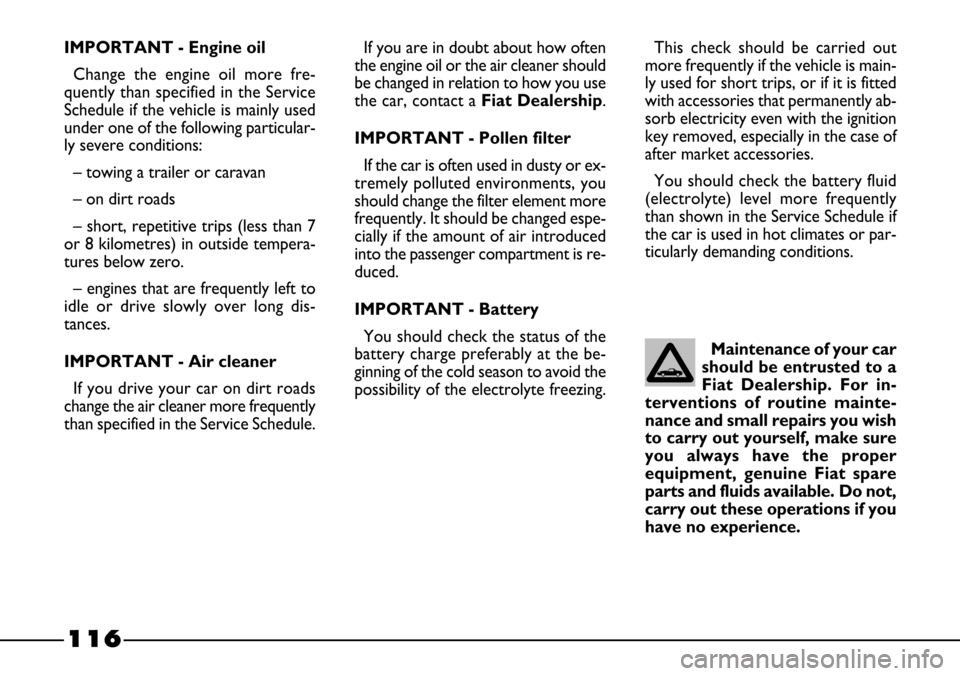
116
This check should be carried out
more frequently if the vehicle is main-
ly used for short trips, or if it is fitted
with accessories that permanently ab-
sorb electricity even with the ignition
key removed, especially in the case of
after market accessories.
You should check the battery fluid
(electrolyte) level more frequently
than shown in the Service Schedule if
the car is used in hot climates or par-
ticularly demanding conditions. IMPORTANT - Engine oil
Change the engine oil more fre-
quently than specified in the Service
Schedule if the vehicle is mainly used
under one of the following particular-
ly severe conditions:
– towing a trailer or caravan
– on dirt roads
– short, repetitive trips (less than 7
or 8 kilometres) in outside tempera-
tures below zero.
– engines that are frequently left to
idle or drive slowly over long dis-
tances.
IMPORTANT - Air cleaner
If you drive your car on dirt roads
change the air cleaner more frequently
than specified in the Service Schedule.If you are in doubt about how often
the engine oil or the air cleaner should
be changed in relation to how you use
the car, contact a Fiat Dealership.
IMPORTANT - Pollen filter
If the car is often used in dusty or ex-
tremely polluted environments, you
should change the filter element more
frequently. It should be changed espe-
cially if the amount of air introduced
into the passenger compartment is re-
duced.
IMPORTANT - Battery
You should check the status of the
battery charge preferably at the be-
ginning of the cold season to avoid the
possibility of the electrolyte freezing.Maintenance of your car
should be entrusted to a
Fiat Dealership. For in-
terventions of routine mainte-
nance and small repairs you wish
to carry out yourself, make sure
you always have the proper
equipment, genuine Fiat spare
parts and fluids available. Do not,
carry out these operations if you
have no experience.
Page 118 of 170
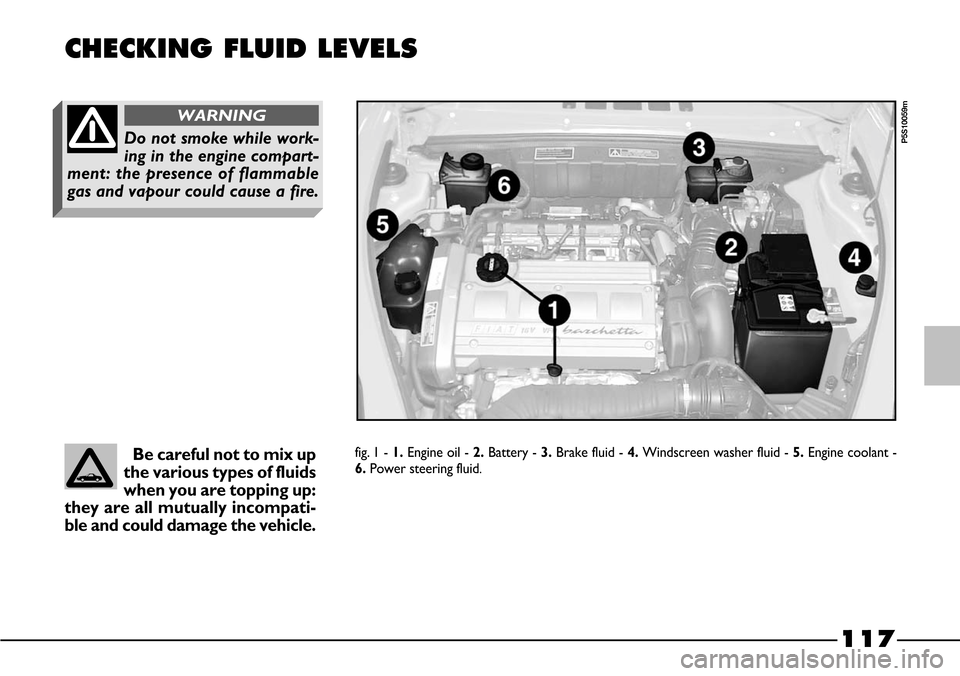
117
CHECKING FLUID LEVELS
P5S10059m
Be careful not to mix up
the various types of fluids
when you are topping up:
they are all mutually incompati-
ble and could damage the vehicle.fig. 1 -1. Engine oil - 2. Battery - 3. Brake fluid - 4. Windscreen washer fluid - 5. Engine coolant -
6. Power steering fluid.
Do not smoke while work-
ing in the engine compart-
ment: the presence of flammable
gas and vapour could cause a fire.
WARNING
Page 119 of 170
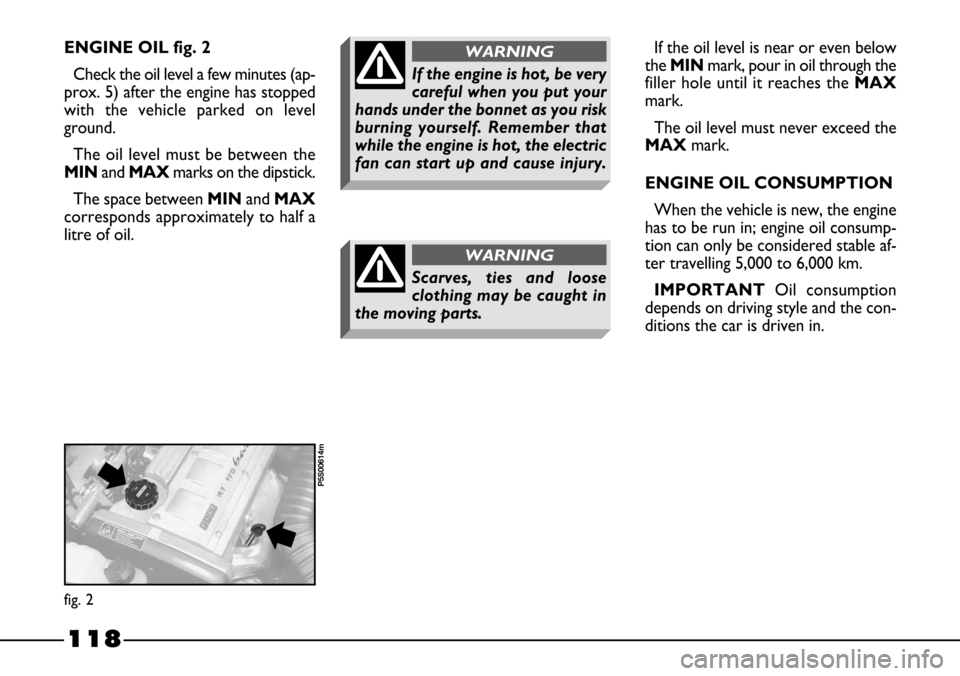
118
ENGINE OIL fig. 2
Check the oil level a few minutes (ap-
prox. 5) after the engine has stopped
with the vehicle parked on level
ground.
The oil level must be between the
MINand MAXmarks on the dipstick.
The space between MINand MAX
corresponds approximately to half a
litre of oil.If the oil level is near or even below
theMIN mark, pour in oil through the
filler hole until it reaches the MAX
mark.
The oil level must never exceed the
MAXmark.
ENGINE OIL CONSUMPTION
When the vehicle is new, the engine
has to be run in; engine oil consump-
tion can only be considered stable af-
ter travelling 5,000 to 6,000 km.
IMPORTANTOil consumption
depends on driving style and the con-
ditions the car is driven in.
fig. 2
P5S00614m
If the engine is hot, be very
careful when you put your
hands under the bonnet as you risk
burning yourself. Remember that
while the engine is hot, the electric
fan can start up and cause injury.
WARNING
Scarves, ties and loose
clothing may be caught in
the moving parts.
WARNING
Page 120 of 170
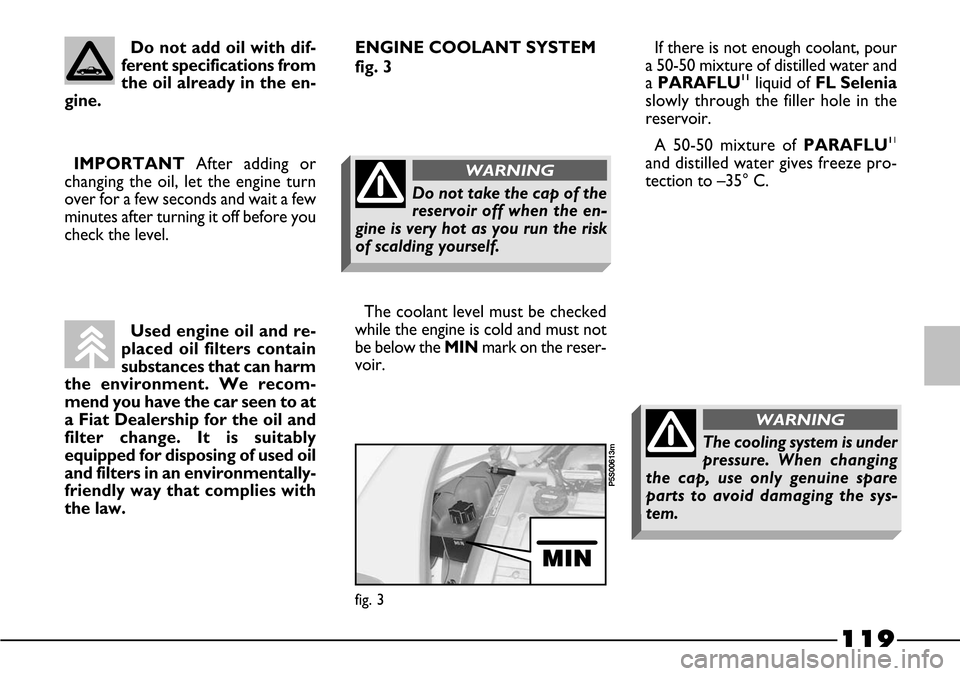
119
Used engine oil and re-
placed oil filters contain
substances that can harm
the environment. We recom-
mend you have the car seen to at
a Fiat Dealership for the oil and
filter change. It is suitably
equipped for disposing of used oil
and filters in an environmentally-
friendly way that complies with
the law.ENGINE COOLANT SYSTEM
fig. 3If there is not enough coolant, pour
a 50-50 mixture of distilled water and
a PARAFLU
11liquid of FL Selenia
slowly through the filler hole in the
reservoir.
A 50-50 mixture of PARAFLU
11
and distilled water gives freeze pro-
tection to –35° C. Do not add oil with dif-
ferent specifications from
the oil already in the en-
gine.
IMPORTANT After adding or
changing the oil, let the engine turn
over for a few seconds and wait a few
minutes after turning it off before you
check the level.
fig. 3
P5S00613m
The coolant level must be checked
while the engine is cold and must not
be below the MINmark on the reser-
voir.
Do not take the cap of the
reservoir off when the en-
gine is very hot as you run the risk
of scalding yourself.
WARNING
The cooling system is under
pressure. When changing
the cap, use only genuine spare
parts to avoid damaging the sys-
tem.
WARNING
Page 121 of 170
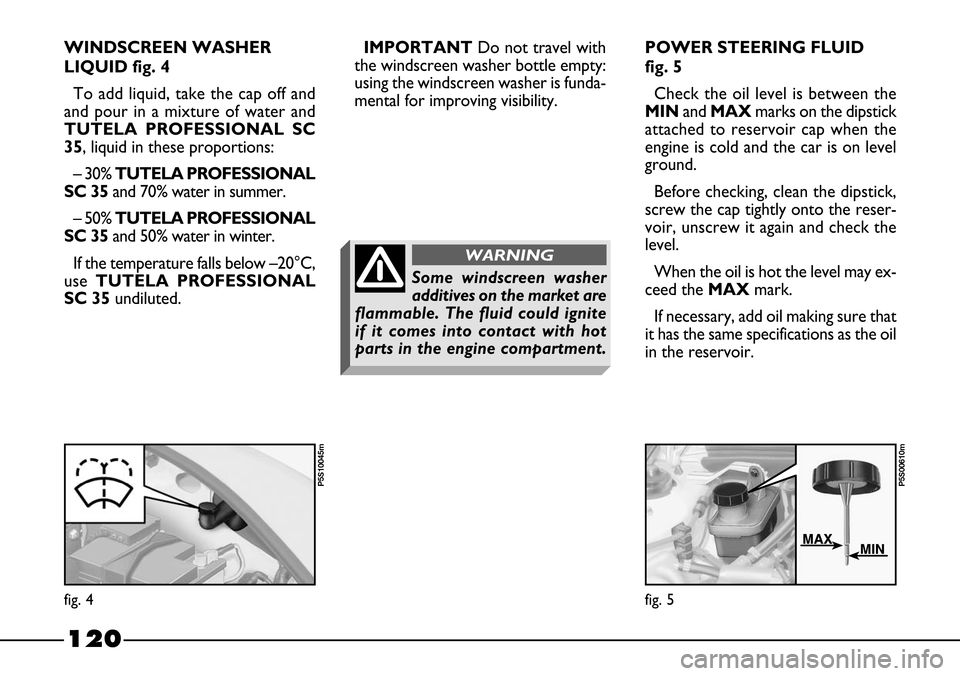
120
WINDSCREEN WASHER
LIQUID fig. 4
To add liquid, take the cap off and
and pour in a mixture of water and
TUTELA PROFESSIONAL SC
35, liquid in these proportions:
– 30% TUTELA PROFESSIONAL
SC 35and 70% water in summer.
– 50% TUTELA PROFESSIONAL
SC 35and 50% water in winter.
If the temperature falls below –20°C,
use TUTELA PROFESSIONAL
SC 35undiluted.POWER STEERING FLUID
fig. 5
Check the oil level is between the
MINand MAXmarks on the dipstick
attached to reservoir cap when the
engine is cold and the car is on level
ground.
Before checking, clean the dipstick,
screw the cap tightly onto the reser-
voir, unscrew it again and check the
level.
When the oil is hot the level may ex-
ceed the MAXmark.
If necessary, add oil making sure that
it has the same specifications as the oil
in the reservoir. IMPORTANT Do not travel with
the windscreen washer bottle empty:
using the windscreen washer is funda-
mental for improving visibility.
fig. 4
P5S10045m
fig. 5
P5S00610m
Some windscreen washer
additives on the market are
flammable. The fluid could ignite
if it comes into contact with hot
parts in the engine compartment.
WARNING
Page 122 of 170
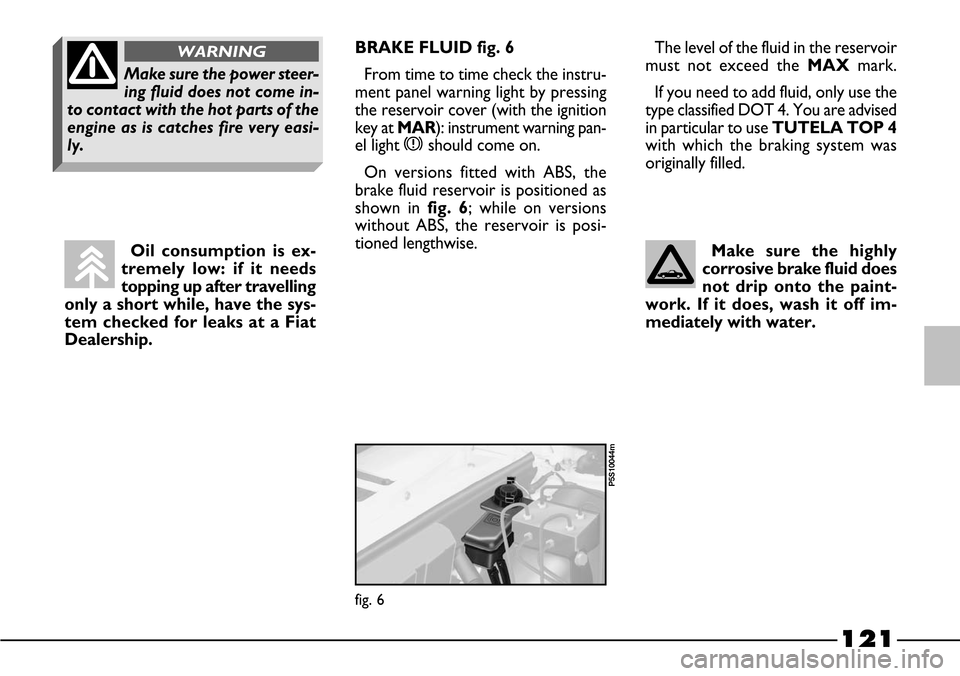
121
Oil consumption is ex-
tremely low: if it needs
topping up after travelling
only a short while, have the sys-
tem checked for leaks at a Fiat
Dealership.
fig. 6
P5S10044m
The level of the fluid in the reservoir
must not exceed the MAXmark.
If you need to add fluid, only use the
type classified DOT 4. You are advised
in particular to use TUTELA TOP 4
with which the braking system was
originally filled. BRAKE FLUID fig. 6
From time to time check the instru-
ment panel warning light by pressing
the reservoir cover (with the ignition
key at MAR): instrument warning pan-
el light xshould come on.
On versions fitted with ABS, the
brake fluid reservoir is positioned as
shown in fig. 6; while on versions
without ABS, the reservoir is posi-
tioned lengthwise.
Make sure the highly
corrosive brake fluid does
not drip onto the paint-
work. If it does, wash it off im-
mediately with water.
Make sure the power steer-
ing fluid does not come in-
to contact with the hot parts of the
engine as is catches fire very easi-
ly.
WARNING